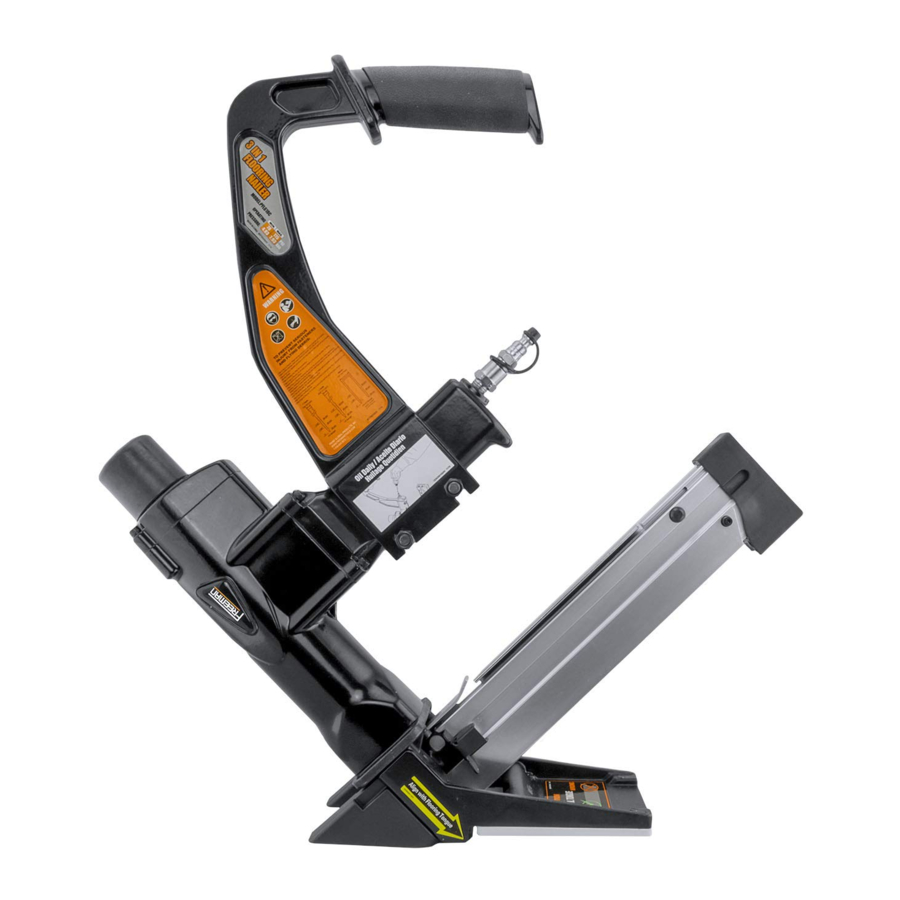
Freeman PFL618BR Manual
- Manual (19 pages) ,
- User manual (5 pages) ,
- Manual (5 pages)
Advertisement

GENERAL SAFETY RULES
The warnings and precautions discussed in the manual cannot cover all possible conditions and situations that may occur. It must be understood by the user that common sense and caution are factors which cannot be built into this product, but must be supplied by the user.
SAVE THIS MANUAL
- Keep this manual for the safety warnings and precautions, operating, inspection, maintenance. Keep this manual and the receipt in a safe and dry place for future reference.
To avoid serious personal injury. do not attempt to use this product until you read thoroughly and understand completely this manual. Save this manual and review frequently for continuing safe operation and instructing others who may use this tool.
SYMBOLS
- In this manual, on the labels, packages and all other information provided with this tool. The following signal words and meanings are intended to explain the levels of risk associated with this tool.
| SYMBOLS | SIGNAL | MEANING |
 | WARNING: | Indicates a potentially hazardous situation, which, if not avoided, could result in death or serious injury. |
 | CAUTION: | Indicates a potentially hazardous situation, which, if not avoided, may result in minor or moderate injury. |
 | CAUTION: | (Without symbol) Indicates a situation that may result in property damage. |
WORK AREA
- Keep the work area clean and well lighted. Cluttered benches and dark areas increase the risks of accidents.
- Do not operate the tool in explosive atmospheres, such as in the presence of flammable liquids, gases, or dust. The tool creates a spark which may ignite flammable liquids, gases or dust.
- Keep bystanders, children, and others away while operating the tool. Distractions could result in improper use and cause injury.
- Avoid unintentional misfires. Always use caution to avoid accidentally firing. Do not point towards yourself or anyone whether it contains fasteners or not.
PERSONAL SAFETY
- Always wear eye protection. Operator and others in the work area should always wear ANSI—approved safety goggles with side shields. Eye protection is used to guard against flying fasteners and debris, which may cause severe eye injury. You can use the goggles packed with the tool.
- Always wear hearing protection when using the tool. Prolonged exposure to high intensity noise is able to cause hearing loss.
- Use safety equipment. A dust mask. non— skid safety shoes and a hard hat must be used for the applicable conditions. Wear a full face shield if you are producing metal filings or wood chips.
- Dress properly. Do not wear loose clothing or jewelry. Contain long hair. Keep your hair, clothing, and gloves away from moving parts. Loose clothes, jewelry, or long hair can be caught in moving parts.
- Stay alert, watch what you are doing and use common sense when operating a power tool. Do not use tool while tired or under the influence of drugs, alcohol, or medication. A moment Of inattention while operating the tool may cause serious injury.
- Keep proper footing and balance at all times. Proper footing and balance enables better control of the tool in unexpected situations.
- Do not use on a ladder or unstable supports. Stable footing on a solid surface enables better control of the tool in unexpected situations.
- Make sure the hose is free of obstructions or snags. Entangled or snarled hoses can cause loss of balance or footing and may become damaged or result in injury.
TOOL USE AND CARE
- Know this tool. Read manual carefully, learn its applications and limitations, as well as the specific potential hazards related to this tool. Use only fasteners that are recommended for your models. Do not use the wrong fasteners or load the fasteners incorrectly. Check for misalignment or binding of moving parts, breakage of parts, and any other condition that may affect the tool's operation. If damaged, have the tool serviced before using. Many accidents are caused by poorly maintained tools.
- Maintain tools with care. Keep tool clean. A properly maintained tool, reduces the risk of binding and is easier to control.
- Store tools out of the reach of children and other untrained people. Tools are dangerous in the hands of untrained users.
- Check operation of the tool before use.
- Do not force tool. Use the correct tool for your application. The correct tool will do the job better and safer at the rate for which it is designed.
- Use clamps or another practical way to secure and support the workpiece to a stable platform. Holding a tool by hand or against the body is unstable and may lead to loss Of control.
- Keep the tool and its handle dry, clean and free from oil and grease. Always use a clean cloth when cleaning. Never use brake fluids, gasoline, petroleum—based products, or any strong solvents to clean your tool.
- Do not use the tool as a hammer.
- Never use this tool in a manner that could cause a fastener to be directed toward anything other than the workpiece.
- Always carry the tool by the handle. Never carry the tool by the air hose.
- Do not use the tool if it leaks air or does not function properly.
- Do not operate the tool if it does not contain a legible warning label.
TOOL SERVICE
- Use only accessories that are identified by the manufacturer for the specific tool model.
- Use of unauthorized parts or failure to follow maintenance instructions may create a risk of injury.
- Use only the lubricants supplied with the tool or specified by the manufacturer.
- Tool service must be performed only by qualified repair personnel.
OPERATION
- Do not drive fasteners near edge of material. The workpiece may split causing the fastener or ricochet, injuring you or people around.
- Do not drive fasteners on top of other fasteners or with the tool at an overly steep angle as this may cause deflection of fasteners which could cause injury.
- Do not actuate the tool unless you intend to drive a fastener into the workpiece.
- Always handle the tool with care:
- Respect the tool as a working implement.
- Never engage in horseplay.
- Keep others a safe distance from the tool while tool is in operation as accidental actuation may occur, possibly causing injury.
AIR SUPPLY AND CONNECTIONS
- The connector on the tool must not hold pressure when air supply is disconnected. If an incorrect fitting is used, the tool can remain charged with air after disconnecting and thus will be able to drive a fastener even after the air line is disconnected, possibly causing injury.
- Do not use oxygen, combustible gases or bottled gasses as a power source for this tool. Explosion may occur, causing injury or death.
- Do not connect with an air compressor which can potentially exceed 200 Psi. As tool may burst, possibly causing injury.
- Always disconnect air resource:
- Before making adjustments.
- When servicing the tool.
- When clean a jam.
- When tool is not in use.
- When moving to a different work area, as accidental actuation may occur, causing injury.
LOADING TOOL
- Do not load the tool with fasteners when any one of the operating controls is activated.
- Never place a hand or any part of body in fastener discharge area of tool.
- Never point tool at anyone.
The warnings and precautions discussed above cannot cover all possible conditions and situations that may occur. It must be understood by the user that common sense and caution are factors which cannot be built into this product, but must be supplied by the user.
UNPACKING
- This tool has been shipped completely assembled.
- Make sure that all items listed in the packing list are included.
- Carefully remove the tool and any accessories from the box.
- Inspect the tool carefully to make sure no breakage or damage occurred during shipping.
- Do not discard the packing material until you have carefully inspected and satisfactorily operated the tool.
- If any parts are damaged or missing, please call 1-888-669-5672.
PACKING LIST
3 In I flooring nailer
Carrying case
Mallet
Air connector
Adjustment tools
Lubrication oil
Anti—dust cap
0.315"foot plat
Instruction manual
Safety goggles
If any parts are missing do not operate this tool until the missing parts are replaced. Failure to do so could result in possible serious personal injury.
Do not attempt to modify this tool or create accessories not recommended for use with this tool. Any such alteration or modification is misuse and could result in hazardous condition leading to possible serious personal injury.
FEATURES
SPECIFICATIONS
| Operation pressure: | 70-1 lopsi |
| Nails capacity: | L: 100pcs T: 100pcs U: 2 x 45pcs to 2 x 60pcs |
| Tool weight: | 12 lbs |
| Air inlet: | 1/4"NPT |
Fasteners:
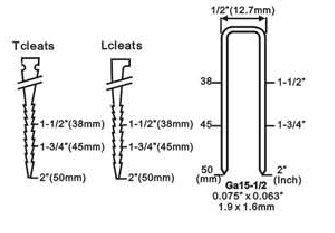
Compatible with Stanley Bostitch & Generic Brands 112" Staples, T-Cleats, & L-Cleats.
FEATURES
- REVOLUTIONARY 3 IN 1 DESIGN
For use with Staples, T=CIeats and L=CIeats. - ERGONOMICALLY DESIGNED HANDLE
For ease of operation and reduced fatigue. - ANODIZED ALUMINUM MAGAZINE
For long lasting durability. - DURABLE CONSTRUCTION
Light weight and durably constructed of high— strength aluminum and heat treated steel parts. - INCLUDED MALLET
OPERATION
LOADING CLEAT NAILS
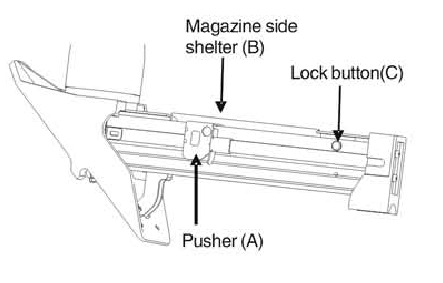
- Pull the Pusher(A) back to the end of magazine. Lock pusher in the place by using Lock button(C). Then pull the Magazine side shelter(B) back.
- Place full clip of desired Fasteners into magazine from the side. Up to 100 cleat nails can be loaded into magazine. Be noted that, when loading the L Cleat nails, the side with the L head should be in the left of the Magazine side shelter(B). Press the Lock button(C), then the Pusher(A) set back to make the Magazine Side shelter(B) down back.
LOADING STAPLES
- Pull the Pusher(A) back to the end of magazine. Lock pusher in the place by using Lock button(C). Then pull the Magazine side shelter(B) back.
- Place a full clip Of 1/2"Crown Staples in the magazine from the top. Up to 2 x 45pcs to 2 x 60pcs can be loaded into the tool.
- Press the Lock button(C), then the Pusher(A) sets back to make the Magazine side shelter(B) down back.
The tool may fire when it first connected to the air resource. Always connect the tool to the air resource before loading fasteners to prevent injury from unintended cycling. Always make sure the tool's magazine is empty at the beginning of each work session. before connecting to an air resource.
CHANGE THE FOOT PLATE
The tool is equipped with a factory pre-installed 1/4"foot plate(D). And an additional uninstalled 0.315" foot plate. To change the plate:
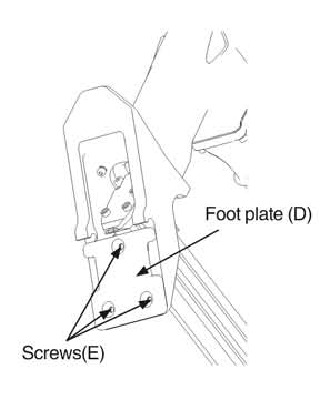
- Disconnect the tool from the air resource.
- Empty the magazine completely.
- Fire the tool into a piece of scrap wood to ensure there is no compressed air or fasteners left in the tool.
- Set the tool on its side to expose the three screws(E).
- Remove the three screws(E), then, remove the foot plate.
- Align the three screw holes in the replacement foot plate with the three threaded mounting holes.
- Using the three screws you removed just now, secure the replacement foot plate to the tool.
- Ensure the correct Foot Plate is installed by firing into a scrap piece of flooring and checking for proper fastener placement.
Disconnect the tool from the air source whenever changing the foot plate. Make sure there is no fastener in magazine before changing the foot plate.
SETTING THE AIR PRESSURE
The amount of air pressure required depends on the size of the fasteners and the workpiece material. Begin testing the depth of drive by driving a test nail into the same type of workpiece material used for the actual job. Drive a test fastener with the air pressure set at 90— 95psi. Raise or lower the air pressure to find the lowest setting that will perform the job with consistent results.
It may be possible to achieve the desired depth with air pressure adjustments alone. If finer adjustments are needed, use the drive depth adjustment on the
OPERATING THE TOOL
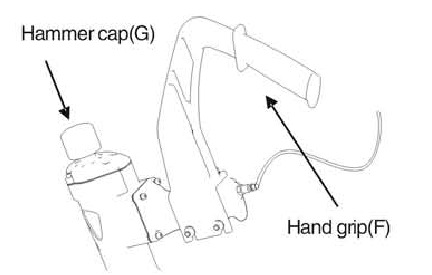
- Attach the tool to the air resource. Start your compressor and check the pressure, making sure it is set between 70—110 psi. Do not exceed the maximum 120psi.
- Hold the Hand grip(F) securely and Press Foot plate(D) to the work surface. Make sure the plate is over the Fastener target position.
- Press down hard so that the foot plate is firmly contacting the work surface. Then, using the mallet packed with the Tool, strike the hammer cap(G) firmly to drive the fastener into work surface. Lift the tool off the work surface.
Repeat this process until the job is completed. - When finished, make sure to Store the tool in a dean, dry, safe location out of reach of children and other unauthorized People.
Extreme caution must be used whenever this tool is connected to an air resource.
If the tool is dropped, or if the Hammer cap(F) is accidentally struck, then the tool will fire a fastener, potentially causing SERIOUS PERSONAL INJURY.
Keep your feet off the tool.
Before using the tool on a floor, test the tool on a scrap piece of wood. Adjust the driving depth by providing more or less air pressure. Never exceed 120PSI.
CLEARING JAMS
Occasionally, fasteners may become jammed in the firing mechanism of the tool, making the tool inoperable. To remove a jammed fastener, follow the steps below:
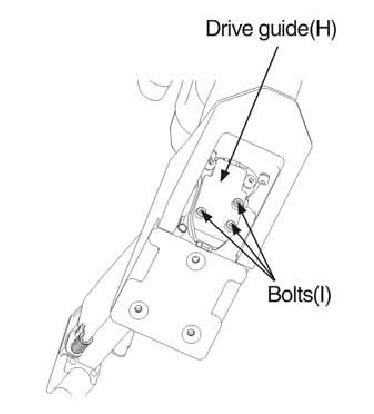
- Disconnect the tool from air resource.
- Empty the magazine. Make sure all fasteners are removed.
- Try to fire the tool into a piece Of scrap Wood or flooring to make sure that its incapable of firing any fasteners.
- Lean the tool back. With the Drive guide(H) facing away from you, remove the three Bolts(l). Then remove the Drive guide(H) to expose the jammed fastener.
- Removed jammed fastener, using pliers or a Screwdriver if required.
- Replace the Drive guide(H) and Bolts(l).
- Reload the tool with fasteners. then, reconnect the air resource to the tool.
- Press the Drive guide(H) against a piece of wood, and test fire the fasteners several times to check for proper operation. If the tool is properly firing, you may continue using the tool. If the tool fails to perform properly, immediately discontinue use and have the tool repaired by a qualified service technician. When finished working, disconnect the air resource.
- Remove fasteners. Discharge any trapped air. Then store the tool in a clean, dry, safe location out of reach of children.
Make sure there is no fastener in magazine before clearing a jam.
Disconnect the tool from the air source whenever clearing a jam. After disconnecting the tool from the air compressor, there should still be enough air pressure to fire the tool. After the air hose is disconnected, always fire the tool into scrap wood repeatedly to make sure all of the compressed air is expended.
MAINTENANCE
Any time inspection, maintenance, and cleaning are done:
- Disconnect the tool from the air resource.
- Empty the magazine completely
ANTI-DUST
Each FREEMAN tool is packed with an anti—dust cap on the air connector, check it after unpacking. Keep the anti—dust cap to cover the air connector when the tool is not in use to prevent the dust.
LUBRICATION
This tool is uniquely designed not to need daily lubrication. But lubrication is required for best performance after long periods of use. Oil for pneumatic fastening tools is added through the air line connection and will lubricate internal parts. Do not use detergent oil or additives as these lubricants will cause accelerated wear to the seals and bumpers in the tool, resulting in poor tool performance and frequent tool maintenance.
Lubricate tool only with specified lubricants.
CLEARING
Avoid using solvents when cleaning plastic parts. Most plastics are susceptible to damage from various types of commercial solvents and maybe damaged by their use. Use clean cloths to remove dirt, dust, oil, grease, etc.
Do not at any time let brake fluids, gasoline, petroleum—based products, penetration oils, etc. come in contact with plastic parts. Chemicals can damage, weaken or destroy plastic which may result in serious personal injury.
COLD WEATHER OPERATION
For cold weather operation, near and below freezing, the moisture in the air line may freeze and prevent tool operation. We recommend the use of air tool lubricant or permanent antifreeze (ethylene glycol) as a cold weather lubricant.
Do not store tools in a cold weather environment to prevent frost or ice formation on the tools' operating valves and mechanisms that could cause tool failure.
RECOMMENDED HOOKUP
The air compressor must be able to maintain a minimum of 70psi when the tool is being used. An inadequate air supply can cause a loss of power and inconsistent driving.
Do not connect with an air compressor which can potentially exceed 200psi. As tool may burst, possibly causing injury.

TROUBLE SOLVING
| PROBLEMS | POSSIBLE CAUSES | SUGGESTED SOLUTIONS |
Air leaking in head cap |
|
|
Lack of power. Slow to cycle |
|
|
Not shooting fasteners |
|
|
Fasteners are jammed in the tool frequently |
|
|
Use only Freeman Authorized Repair Parts. For questions please call 1—888—669—5672or visit our website at http://www.freemantools.com
WEARING PARTS
Repair parts can be ordered from our website: http://www.freemantools.com
HTTP://WWW.FREEMANTOOLS.COM
1-888-669-5672
Documents / Resources
References
Download manual
Here you can download full pdf version of manual, it may contain additional safety instructions, warranty information, FCC rules, etc.
Advertisement















Need help?
Do you have a question about the PFL618BR and is the answer not in the manual?
Questions and answers